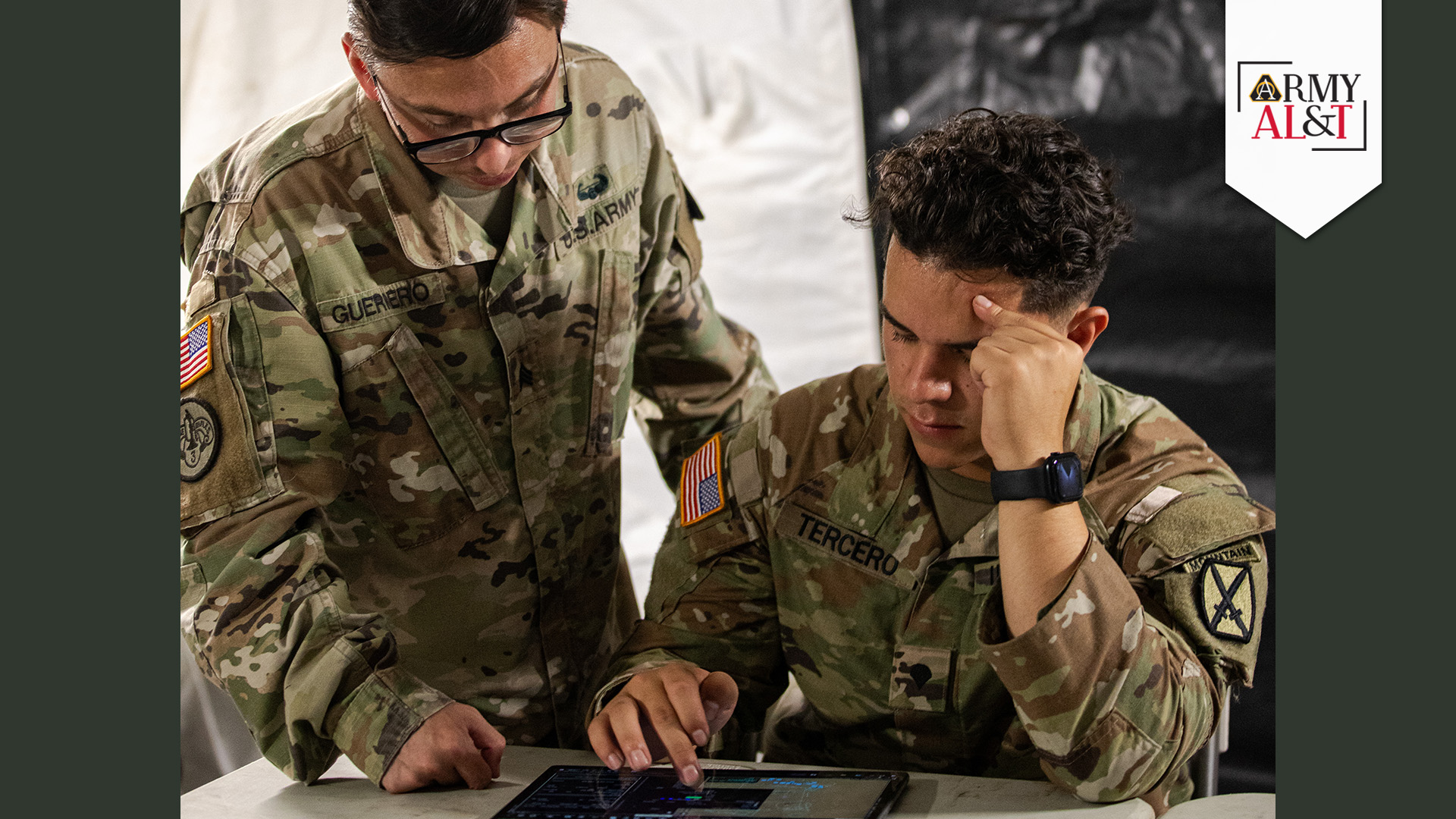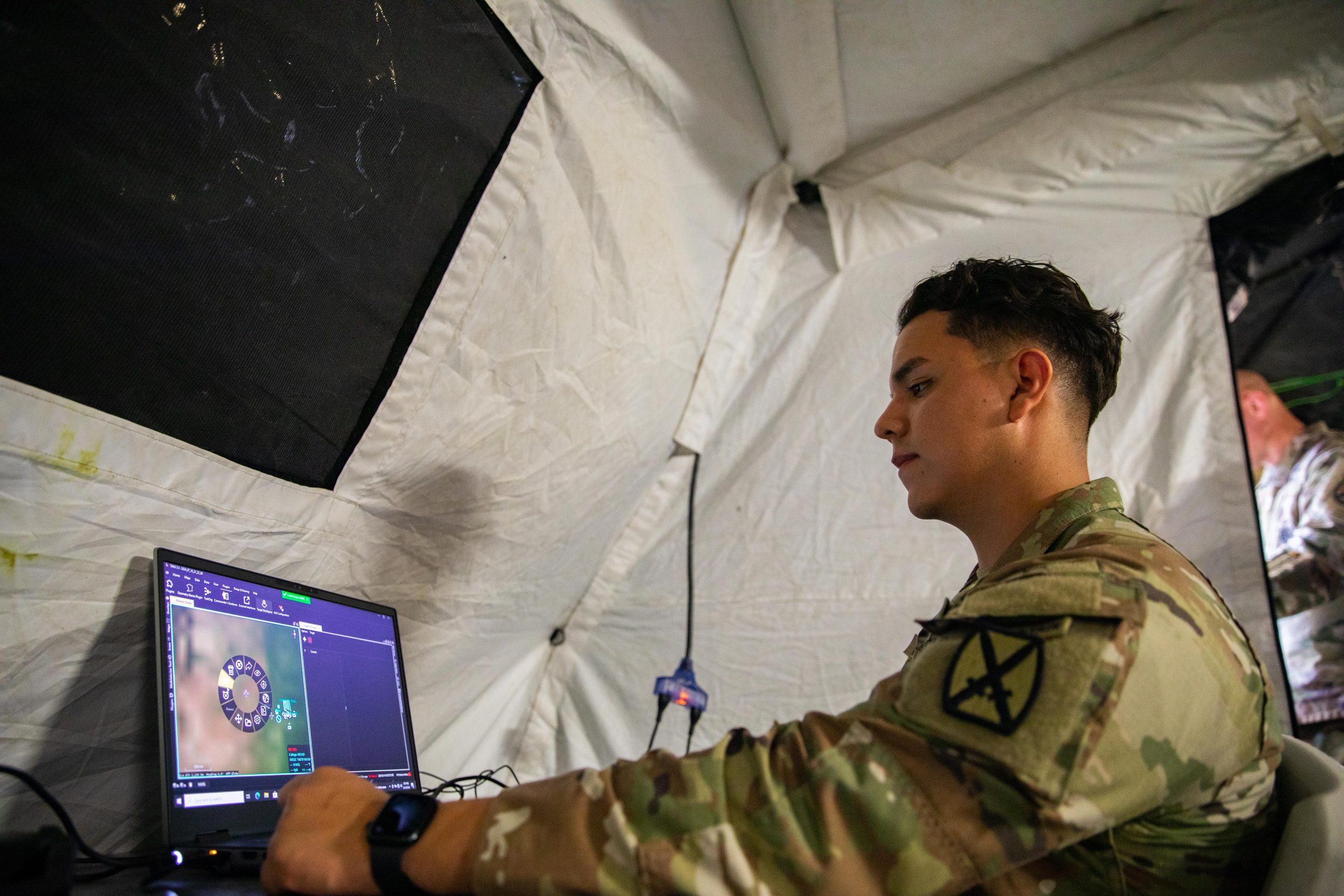
GET READY: Fire support specialists Sgt. Jonathan Guerrero, left, and Spc. Brantley Tercero, assigned to the 10th Mountain Division Artillery, use AFATDS AXS to enhance the readiness of 10th Mountain Division Soldiers. (Photo by Spc. Salvador Castro, 27th Public Affairs Detachment)
by Danielle Kress and Maj. Henry Castillo
The need for quick, effective and intuitive software that will help Soldiers execute fires is crucial to a unit’s ability to fight in fast-moving and large-scale combat operations. Which is why the Army’s 30-year-old software for fires is getting an upgrade.
The Army’s software for fires, known as the Advanced Field Artillery Tactical Data System (AFATDS), has long provided reliability in coordinating, controlling and executing fires and effects. Because it is built as a monolithic piece of software, however, it requires an extensive process for updates, and current operational environments demand an intuitive, more modern fires software that can provide new capabilities at the speed of need.
The new software, dubbed AFATDS Artillery Execution Suite (AXS), will be intuitive and data-centric, allowing for quicker upgrades and a more adaptable system—with the heart of the solution being the incorporation of Soldier feedback and a partnership of development with operational units.
WORKING WITH THE 10TH MOUNTAIN DIVISION ARTILLERY
According to Pam Savage-Knepshield, Ph.D., senior human factors engineer and the human systems integration lead for the Program Executive Office Command, Control, Communications and Network’s (PEO C3N) Product Manager Fire Support Command and Control, bridging the gaps between the system and the user is at the foundation of making the software work for the Soldier. It’s also in understanding those gaps that the Army discovers exactly where the software can be improved.
“Soldiers who use AFATDS have a lot of information that they have to process very quickly,” said Savage-Knepshield. “The simpler we can make the system, the less they actually have to remember how to use the system. They can focus on their job and not the buttonology.”
On July 16, 2024, Soldiers from the 10th Mountain Division Artillery at Fort Drum, New York, were given the software to conduct a usability test to see how smoothly and quickly they could navigate and complete tasks. With no formal guidance and having never seen AFATDS AXS, they were asked to complete tasks like select and add units, create a target, install plugins and more.
Overall, participants experienced success navigating through the software, relying on the system’s intuitiveness to help guide them through completion of the task.
The parts that didn’t come so easily are what informed specific design changes to enhance the system’s usability. After one time working with the software, Soldiers offered actionable feedback on more than 40 items, such as implementing a systemwide search capability, sorting drop-down lists in alphabetical order and recoloring graphics to make targets more visible within the map.
“The details matter,” said Maj. Henry Castillo, assistant product manager for AFATDS AXS, who understands how important it is for a fires software to operate quickly and effectively.
“We can all relate to the frustration of navigating a website or app that doesn’t work properly. User experience is key to success, especially when you need to be able to navigate in a matter of seconds. We want our Soldiers to have a system that works seamlessly. There is no time for hesitation when we get into a real-world situation. It’s what makes our work with the 10th Mountain Division so critical. We are getting real feedback.”
There were a lot of positive Soldier comments as well. “You don’t have to be experienced to work through it,” said Sgt. Ethan Gash, fire control non-commissioned officer with the 10th Mountain Division, who participated in the usability test. “In two to three hours, I’d be perfect on using this.”
Some Soldiers also commented on the speed and said that the system “is 10 times faster” than the legacy AFATDS system, while others highlighted the fact that it was more defined and “you could tell where everything was,” which will be key as the software eventually makes its way throughout the Army for wider use in fiscal year 2025.

OPERATIONAL FEEDBACK: Spc. Brantley Tercero with the 10th Mountain Division Artillery provides feedback on AFATDS AXS by completing a usability test. The test measures the system’s ease of use against stringent usability targets, including how quickly and accurately Soldiers can perform critical tasks. Feedback from the test informs software updates, making sure AFATDS AXS meets operational needs. (Photo by Spc. Kade Bowers, 27th Public Affairs Detachment)
A CYCLE OF ITERATIONS AND TRANSFORMATION
The usability test is just one phase in what will be a continuous cycle in the development of AFATDS AXS, with the 10th Mountain Division Artillery serving as the Army’s DevOps unit. PdM FSC2 will continue to prioritize upgrades and improvements based on Soldier feedback, particularly as the 10th Mountain Division uses the software in additional command post exercises and trainings.
“During the Soldier Touch Points [STP], Soldiers are exposed to the software only for the duration of the STP,” said Castillo. “With the 10th Mountain, we are leaving the software with the unit in what we’re calling ‘Unit Transformations.’ We are giving them the opportunity to incorporate it into their training and build the software into the actual architecture of the unit.” As the Army continues to iterate on the software, the goal will be to put new versions into the hands of Soldiers as frequently as possible.
Soldiers are seeing the benefits of the quick turn, as Spc. Brantley Tercero, a fire support specialist with the 10th Mountain Division who took part in two Unit Transformations, said of the vast improvement of AFATDS AXS. “We don’t have to wait for a whole system to be completely updated,” he said. “As soon as one thing is updated, they’re [PEO C3N] sending it to us.”
CONCLUSION
Because AFATDS AXS is based off the government-owned software called Tactical Assault Kit (TAK), the Army foresees training to be simpler and quicker with the software’s look and feel resembling other familiar Army systems. Castillo compares it to adjusting to a new app on your phone. “TAK is the base like your Android phone, and AXS is like an app within that base. Soldiers will be able to spend more time planning and executing rather than learning the software.”
With shorter training time will also come a host of benefits, like improved mission performance and warfighter readiness, reduced life cycle costs and optimized system performance. “This is really going to benefit the Army,” said Savage-Knepshield. “We were given the challenge to reduce training time from 120 hours for AFATDS down to 40 hours, or less. If we can do that, we will not only reduce complexity but provide a tool that transforms the Army’s ability to execute fires and defend our nation.”
DANIELLE KRESS is a public communications specialist at PEO C3N. She holds a B.A. in broadcast journalism from Wilmington University.
MAJ. HENRY CASTILLO is an assistant program manager within PEO C3N. Before PEO C3N, he served as a contracting officer supporting contingency operations at U.S Central Command. He has an M.A. in procurement and acquisition management from Webster University and a B.S. in industrial engineering from the Mother and Teacher Pontifical Catholic University in the Dominican Republic.







